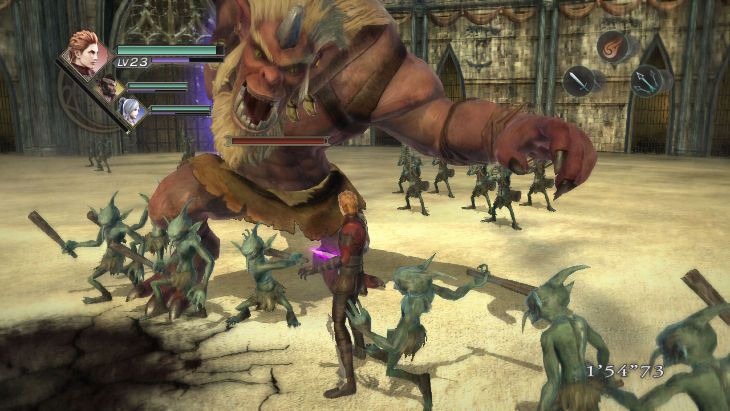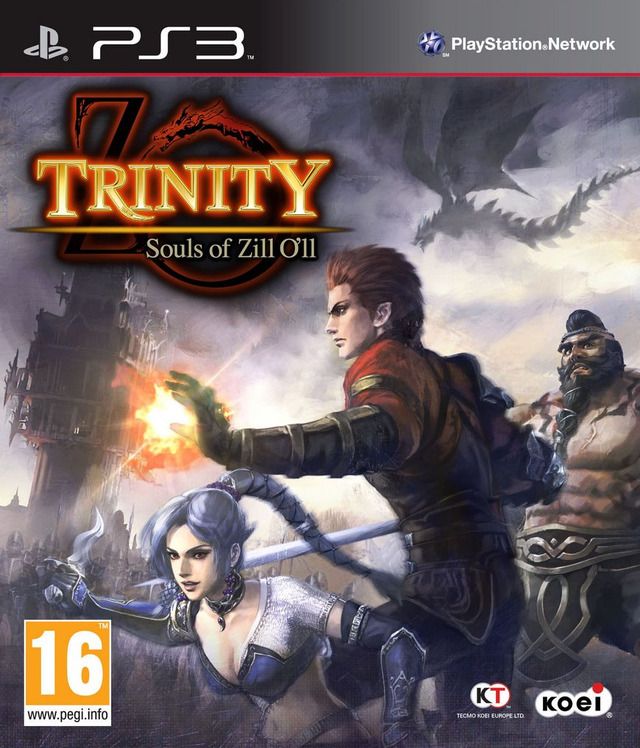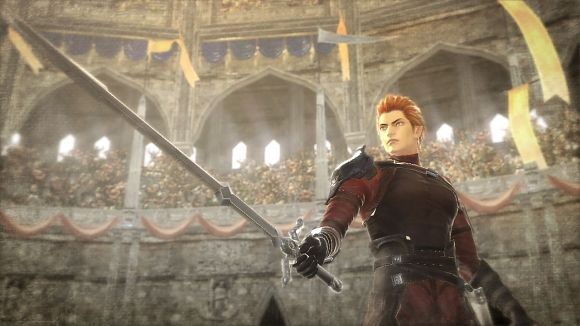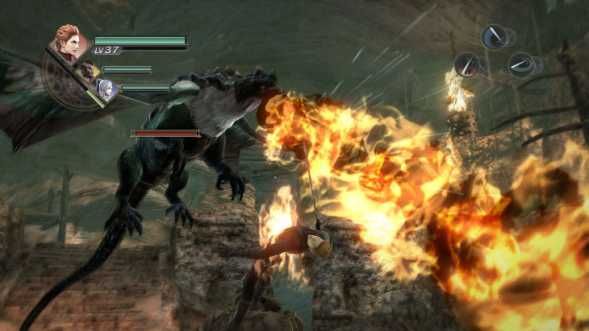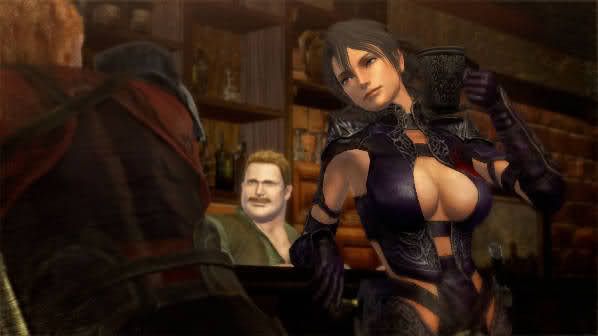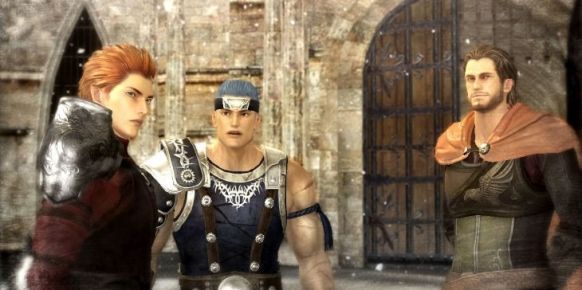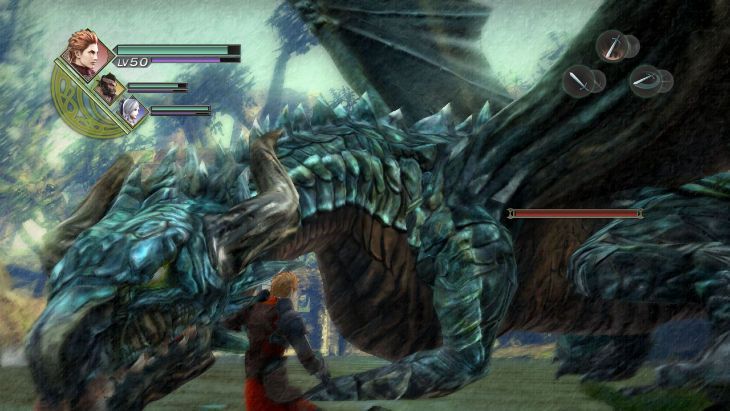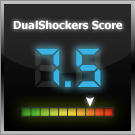While I am always willing to try something new and innovative, sometimes it's fun to just kick back and relax with something you're used to. After all, executing a familiar and functional game could be just as challenging as coming up with something entirely different. These comfort food games tend to be hit or miss; They either execute the predefined formula well or they don't. Trinity: Souls of Zill O'll just barely hits its mark.
You won't be wowed by much of anything in this solid action JRPG, and it has some very serious issues, but if you're a fan of the genre there is a lot to love here. The game certainly falls flat in certain areas, but taken as a whole, I'd say it's worth at least one play-through. When Trinity Souls first caught my eye, I was extremely cautious, taking notice of the names Tecmo Koei and Omega Force. It's a good thing I didn't expect the game to suck, because Trinity Souls turned out to be enjoyable. Although it treads a fine line of established JRPG norms, it does make a few big mistakes.
The game starts off with a nice long cut scene, introducing the player to the world of Dyneskal and the game's story, which I must say I enjoyed. The emperor Balor was a mean, greedy ruler who basically sought to control the world. When he finally achieved this, he made sure it stayed that way by ruling brutally and mercilessly. One day his council had a premonition. He predicted that Balor would not only be defeated and lose his power, but also that it would be by the hands of his own grandson. Not being one to take a chance, Balor had his pregnant daughter murdered. The baby however was rescued from her womb with magic.
Balor also had a son, the prince and the prince had a baby as well, with an elf. It was the magic of this elf that saved the first baby, ruining Balor's plan for the moment. The prince was human, which caused his baby to be born a half elf, a human-elf hybrid looked down upon in a racist kind of way in society. So at this point, Balor ends up with two grandsons instead of none like he had planned. He then leaves his throne in order to murder his son, who was trying to defend the grandsons and his elf wife. Areus, who is our main character, the young half elf, witnesses all of this, which sufficiently explains his cold and careless demeanor. Areus's aspiration is of course, to kill Balor. This all happens in like the first ten minutes of the game.
Things get pretty interesting from that point, even if it only really gets worse for Areus. The story is enjoyable I think, even if the delivery is a little slow most of the time. The weight of the tragedies within the game make the narrative serious and relevant. Dialogue is only spoken during cut scenes and outside of cut scenes you'll do a lot of reading. The characters are developed in a slow if believable way. Areus has understandable trust issues but will have to overcome them for his friends, who he will need to help him achieve his goal. Five hours in, I was pretty interested in what would happen next and I retained that feeling throughout most of the game.
The visuals in this game aren't really good. It's a little sad to have to say about a game that, for the most part I like. However, in all honesty, it just isn't pretty to look at. Everything seems to be rendered with the same engine used in Fist of the North Star, and if you recall, I likened them to the graphics of a good PS2 game. This is pretty much the same situation. The character models are fairly detailed and the rendering is a little block-like and bland. Selene, your female companion, is easy on the eyes, but the lumbering Dagda will probably bring Mr. T to mind. Areus seems a little lanky, but never reaches the level of disturbing androgeny as the guys from the Final Fantasy games.
Environments are varying, even if a little plain and the shadow and light effects are decent. Enemies are pretty varied, although you'll notice a lot of palette swaps deep into the game. The variety between the “giant” enemies is especially noticeable. The visuals are coated in this crosshatch, sketchy kind of filter. It brings to mind Valkyria Chronicles, but it isn't nearly as pretty or artistic. It actually makes the graphics look worse in certain spots. I think that perhaps the developers were onto something, but they just didn't give it the level of polish it needed. They've effectively made already bad graphics worse, which is just unfortunate.
The music in the game is about half and half. The high tempo classical pieces have this really weird kind of repetitiveness about them. It's as though you can always guess what the violinist is going to do because things tend to repeat themselves to such a great extent. Even people who were just sitting in the room with me playing were able to pick up on the recurring melodies in a just a few minutes.
There are a few songs that save the soundtrack. The main theme and all of its variations are pretty awesome. There is also a song with vocals contributed in some foreign language and it too is nice. The less pleasant uptempo music I mentioned is used whenever you are in a dungeon or in battle, and since this is where you'll spend the most of your time in the game, this is the music you'll hear the most. After a while it becomes pretty grating.
The other sounds in the game are all on point. I particularly like the sounds of weapons striking the enemies. Growls, screams and roars are all well done. The voice acting is sub-par. Dagda's voice and dialogue is just not believable or pleasant. The guy who voiced Areus is clearly unable to convey any kind of emotion whatsoever, as his performance is just dry and stale. Don't quote me on this, but I'm pretty sure Selene is voiced by the same actor who did Nel in Star Ocean: Till the End of Time, which is funny because this already seems similar to a Star Ocean game.
The game-play consists mostly of combat, which I'll get to in a bit. The map is something like a centralized hub for all the locations in the game. The towns in this game are just a series of menus and static background art. While it isn't entirely unpleasant, it does indeed give the game a very cheap, very incapable feeling. This series of menus and art would probably work really well in smaller portable titles because the town isn't actually rendered and I'm sure that saves a lot of memory. What's interesting about this though is that for the most part, they serve all the same functions as towns in more traditional RPGs, without the fun or confusion of exploring. You can buy and sell wares and skills at the shops and chat with NPCs at the taverns.
In a way, I rather like this system of menus, although I am sure fully rendered towns would have been better. It is also at these towns that you will pick up your quests, a big part of game-play. Questing is pretty standard fare. Most quests are ridiculously mundane and trite. Go fetch this, kill this many of these, etc. The rewards for completing them are usually some amount of money, experience points and perhaps an item. Completing quests is also needed to progress the story at certain points, which gets pretty sloppy because they don't always go into much detail about it. You can take on multiple quests at a time and the bigger the risk, the bigger the reward.
The dungeons are all fairly straightforward, but they have a few charms that make them unique. Something I thought was cool was that the characters can interact with the environment in various ways. For example, Dagda can beat down rock walls that keep you from progressing and Areus can set fire to weeds to burn enemies. This dynamic manages to give the game something functional and unique, so it's a standout feature.
There are normally huge amounts of enemies in these dungeons and I found it challenging most of the time. You'll want to explore, keeping an eye out for treasure chests and shining spheres. They provide you with a constant stream of items and supplies, but you have to look to find the stuff. Sometimes they try to implement puzzles and similar things but in truth, they never require much more than pulling a switch or two. It's a nice gesture, but it simply isn't relevant. There are even some obstacles that the agile Selene is able to simply glide over and I know that wasn't intended.
The combat and character customization are two of the games very strong points. First off, the combat is hack and slash action. Like the name Omega Force implies, there will be loads of enemies and lots of button mashing. If you've ever shied away from RPGs because of the typically slow nature of their combat and general game-play, Trinity Souls may be your game.
The face buttons are three hot keys and the jump button. The uses of the other face buttons are determined by what skills you set to them. So you can set your sword, fireball and ice attacks to these buttons. You can then use R2 to switch to a different set of hot keys. This basically gives you quick access to six different skills to combo with. It would probably have been better if you could do this twice, giving you access to nine skills, but six is enough.
Combat is fast paced and the system allows you to quickly chain attacks together. You control three characters in battle, one at a time. There doesn't appear to be any sort of way to command the characters you aren't controlling directly, but that's alright because the artificial intelligence does a decent job. Each of them has unique properties, specifically the elemental powers.
You can switch between these characters at any time quickly and easily. This has two important applications. First, since different enemies are weak against different elements, you'll need to switch to be effective. Secondly, it seems like the damage that characters take is at least halved when you aren't controlling them directly. This means that when you see your character getting ready to get pummeled by a powerful enemy attack, if you switch quickly enough, you save a lot of damage.
It doesn't seem like it at first, but after you unlock enough skills, you'll realize that your characters do have the potential to quickly and easily defeat pretty much all the enemies. I say this because the game can be very difficult at times. This is shocking since normally, the enemies pose no threat at all in Omega Force games like Dynasty Warriors. Some enemies will hit your characters for ridiculous amounts of damage, even when you are above the suggested level of a dungeon and have the best armor equipped. Enemies ganging up on you can also turn into an ugly situation really quick.
The significant enemies are pretty big and have huge health bars. They are like mini-bosses, especially the floating eye enemies. You won't be able to defeat these enemies without exercising their elemental weaknesses and this isn't very easy to do. From time to time, a colorful floating reticle will appear over the enemy and then you are supposed to use the relevant elemental attack in order to put them in a broken state where they actually take damage.
The problem with this is that the window of time in which the spell will affect the enemy is just ridiculously short. Sometimes the reticle disappears after just an entire second, and it takes longer than that for the character to finish the animation for the attack. This makes battles that are probably supposed to be quick and strategic into long, irritating displays. It also adds to the already steep difficulty significantly.
They've done some things to try and make the experience not so hard on the player, and these gestures are appreciated. First of all, if a character dies, they are automatically resurected after a certain amount of time. Their max health will be lowered as a punishment, but this can be remedied with items or a save point. Oh yes, the game uses save points. Another much appreciated feature is the health being replenished after each fight. If you had to use items to do this, you would use a whole lot of them.
Also, using magic doesn't draw on any bars or anything like MP in traditional RPGs, so you are allowed to be pretty creative with the combos you pull off. As you battle, you gradually fill a special bar. When it is full, you are able to unleash a powerful blow. This attack usually defeats smaller enemies and sends the big baddies into that desirable break state. Similarly, when the tough enemies get really low on health, you can use the same button input to use a special finishing move.
The character progression is enjoyable, even if it isn't very deep. Each character has three different souls, unlocked as you progress through the game. The souls allow your characters to learn different types of skills. You then want to power these skills up to make them more useful. You unlock skill points as you defeat enemies and these points can be used to power up the skills of the characters. Skills can be powered up twice and although the skill point requirements might seem high, you meet them after just a dungeon or so. The armor, weapon and accessory system is pretty solid if standard. I like that finding good, useful weaponry is easy and not rare like in some other RPGs.
Trinity Souls has a few significant issues that really bring the game down. For one thing, there are too many instances of not knowing what to do next. I don't know how games are still having this issue. Do the developers expect that we already know what we're supposed to be doing? More than a few times, you'll simply wander around the map, hoping to instigate the next cut scene and learn what it is you should be doing. This takes away from the experience, and sometimes made me just turn the game off because of my frustration. I don't like having to go outside the game to learn my objective. That is unacceptable.
Another weighty issue I have with the game is how slowly the story progresses. Where the story actually seems interesting and worth knowing, the game spoon feeds you tiny bits of the narrative between hours and hours of dungeon crawling and mundane quests. It's a problem when so much time passes between story related sequences that you are actually able to forget what has taken place.
While both of these issues are relevant, nothing amounts to what I believe is the games biggest flaw and that is a dire lack of content. Fetch quests and the like aren't really fun to do, so what is to be said of a game that is comprised completely of them? Doing the same activity over and over only works if that activity is fun, like a sports or a fighting game. Repeating something boring is just awful, and this game definitely falls victim to that a lot of the time. If you have a have to convince yourself to play the game, there is something horribly wrong.
Although it is certainly very flawed, Trinity Souls is still a very much playable and functional game. It doesn't raise the bar in any way, and sometimes it barely touches the bar at all. But what it does well is worth recognizing. If you find the first five hours of the game fun, you will probably enjoy the rest of it. The action combat is a pretty big draw and the slowly moving story is rather deep. Other than its flaws, its pretty much what JRPG fans have come to know and love. That being said, genre fans can definitely have a good time with this one.
-
Title: Trinity: Souls of Zill O'll
- Platform Reviewed: PS3
- Developer: Omega Force
- Publisher: Tecmo Koei
- Release date: Available Now
- MSRP: $59.99
- Review copy info: A copy of this title was provided by the publisher to DualShockers Inc. for the purpose of this review.

